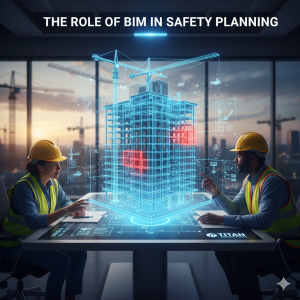The Role of BIM (Building Information Modeling) in Safety Planning
How BIM Helps Visualize Hazards and Improve Coordination

In today’s fast-paced construction environment, safety planning has evolved far beyond paper blueprints and spreadsheets. The introduction of Building Information Modeling (BIM) has rev
olutionized how safety risks are identified, communicated, and mitigated—long before any worker steps onto the site.
What Is BIM and Why It Matters in Safety Planning
Building Information Modeling (BIM) is a digital representation of the physical and functional characteristics of a facility. It’s more than a 3D model—it’s a collaborative tool that integrates data, processes, and workflows from every project stakeholder.
When used for safety planning, BIM allows project teams to simulate real-world conditions and visualize potential hazards during every stage of construction. From identifying high-risk zones to ensuring safe equipment placement, BIM gives safety professionals the foresight needed to prevent accidents before they happen.
Visualizing Hazards Before Construction Begins
Traditional safety planning often relies on static drawings or reports, which can make it difficult to anticipate real-world risks. BIM changes that by offering 4D visualization—linking time and construction sequencing to the 3D model.
This feature allows safety managers to:
-
Detect hazards associated with specific construction phases.
-
Simulate worker movements and equipment operation zones.
-
Identify potential conflicts between trades and workflows.
-
Plan safe access routes, scaffolding setups, and material storage locations.
By spotting risks virtually, teams can adjust their safety strategies early—saving time, money, and, most importantly, lives.
Improved Coordination and Communication
Safety depends on effective communication. BIM enhances coordination between engineers, contractors, and safety officers by centralizing all project data in one shared model. Everyone can view updates in real-time, ensuring all parties are aware of new safety protocols, design changes, and risk assessments.
This level of transparency reduces miscommunication and ensures that safety decisions are data-driven, not assumption-based.
Integrating BIM with Safety Standards and Regulations
BIM also supports compliance with safety regulations such as OSHA and EM 385-1-1 by embedding standards into the digital model. Safety checklists, equipment specifications, and emergency plans can be linked directly to construction phases, ensuring full alignment with government requirements.
For Titan Consultants, this technology strengthens our mission to deliver projects that meet the highest standards of safety, quality, and compliance.
The Future of Construction Safety with BIM
As technology advances, BIM will continue to play a major role in shaping safer, smarter job sites. Integrating BIM with tools like AI, drones, and IoT sensors will allow for predictive safety analytics—helping identify hazards before they even occur.
At Titan Consultants, we believe innovation drives safety. By embracing digital tools like BIM, we help clients plan safer projects, improve efficiency, and build a stronger culture of prevention across the construction industry.
Final Thoughts
Building Information Modeling (BIM) isn’t just changing how we design buildings—it’s transforming how we protect people. Through visualization, coordination, and predictive analysis, BIM empowers safety professionals to move from reactive response to proactive prevention.
📞 Partner with Titan Consultants to integrate advanced safety planning into your next project.
Visit TitanConsultantsGroup.com to learn more about our safety management and compliance solutions.
